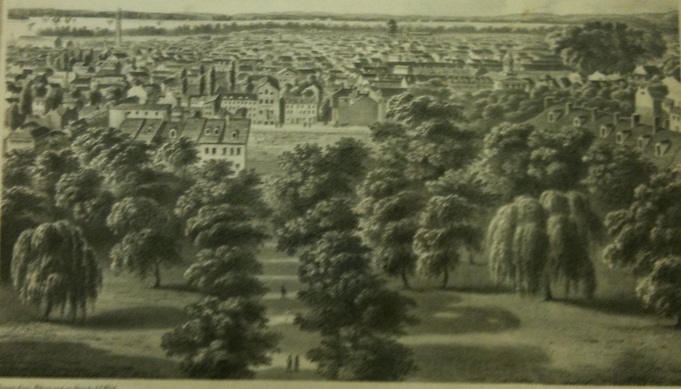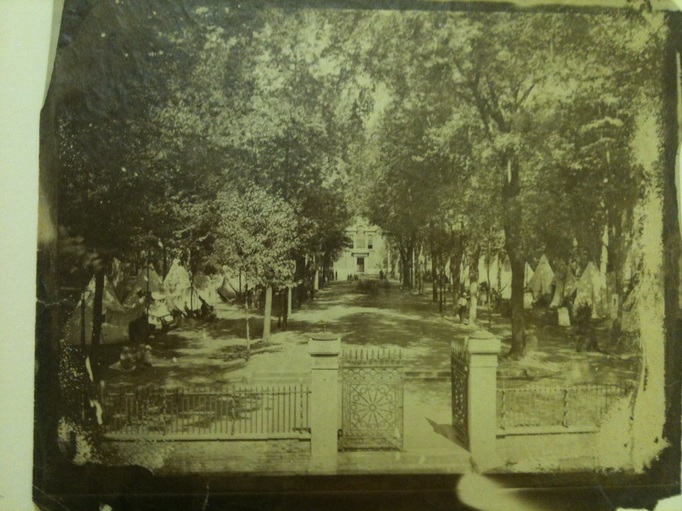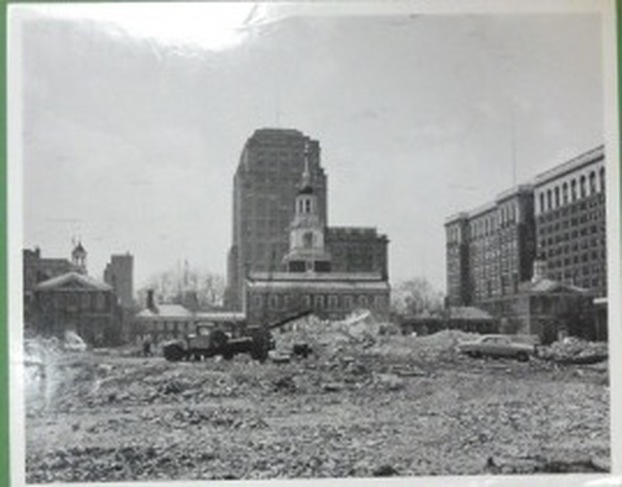You're now near two lost landscapes. You've already visited the lost Norris gardens; now listen to a short description of Peale's wild animal menagerie, and then scroll down to see what used to be on the site where you are now standing.
It's a short walk to where Peale held his wild animal shows. Cross 5th Street, turn left (toward Walnut), and enter Independence Square using the staircase located mid-block. Walk a little past the statue of Commodore Barry and a bit toward the security gate and then turn back to face the rear of Philosophical and Independence Halls. This approximates the perspective of the 1800 print, below. If you look carefully at the image, you can see the sign for Peale’s museum above Philosophical Hall’s rear door. (Click here to see the same vista in 1960 and 2000.) Peale moved his museum in Philosophical Hall in 1794, expanding to the upper floors of the State House (now Independence Hall) in 1802. To keep his menagerie, he had to get permission from the governor to fence off part of the State House Yard for the animal cages and pens.
Peale’s menagerie was meant to turn a profit, in contrast to the large menageries kept by European aristocrats to show off their wealth as well as the skills needed to nurture an exotic animal far from its native habitat. (There was such a show-off menagerie in Philadelphia in the late 1700s, owned by tea merchant Archibald McCall who kept the exotic animals he brought home on his ships at his house at Second and Delancy Streets.)
It’s tempting to imagine Peale’s bear frolicking across a landscape that looks like present-day Independence Square, but the State House Yard has undergone numerous changes since Peale's time. This panoramic view (below) of the neighborhood south of the State House was drawn in 1838. Although you can't go to the top of Independence Hall now to get the same vista, you can approximate it by standing with your back to Independence Hall and looking south toward Walnut. Your view is blocked by the large buildings across the street, but it's clear the the park is now quite different.
It’s tempting to imagine Peale’s bear frolicking across a landscape that looks like present-day Independence Square, but the State House Yard has undergone numerous changes since Peale's time. This panoramic view (below) of the neighborhood south of the State House was drawn in 1838. Although you can't go to the top of Independence Hall now to get the same vista, you can approximate it by standing with your back to Independence Hall and looking south toward Walnut. Your view is blocked by the large buildings across the street, but it's clear the the park is now quite different.
This 1862 photo (below) of an Union Army encampment shows a similar allee (row) of trees to that in the image above, but from the perspective of the Walnut Street gate. To see this view of Independence Square now, walk south to Walnut Street. Looking toward Independence Hall, locate the rear door, which is centered in the photograph below. Allees modeled after those in European royal parks and estates became popular in the U.S. in the mid to late 1800s.
The park you see today, an expanse of manicured grass and walkways that begins at Walnut Street and runs north to Arch, was created by the city and the National Park Service in the 1950s to showcase Independence Hall and other revolutionary-era buildings. To make this park, a dense urban neighborhood that had been developing since the 18th century was largely torn down. The pile of rubble in the photograph above was the buildings located across Chestnut Street from Independence Hall.
There's actually another example of a ghost garden in Independence Square--a Franklinia, a plant rescued from extinction by a Philadelphian in the late 1700s. The one here is on the far side of the security barrier behind Congress Hall. For more specific directions on finding the Franklinia and to learn more about its history, click here.
Image credits: Top: Back of the State House, William Birch, 1800, American Philosophical Society. Second: Panorama of Philadelphia from the State House Steeple Looking South, 1838, courtesy of the Library Company of Philadelphia. Third: Union Army Encampment, September-October 1862, attributed to Frederick de Bourg Richards, courtesy of the Library Company of Philadelphia. Bottom: Independence Hall, 1953, Library of Independence National Historic Park. iPhone with GPS users: visit PhillyHistory.org's mobile site to find additional images of your current location.
Want to revisit this page later or view the pages for all the sites that are part of Ghost Gardens, Lost Landscapes? Click here. Ghost Gardens explores lost, vanished, or forgotten Philadelphia gardens, landscapes, and animals related to those showcased in Of Elephants and Roses, an exhibition by the American Philosophical Society Museum on view until December 31, 2011 (admission is free). Ghost Gardens was funded by The Pew Center for Arts & Heritage through the Heritage Philadelphia Program. Ghost Gardens was created by Erin McLeary and is maintained by the American Philosophical Society Museum.
Want to revisit this page later or view the pages for all the sites that are part of Ghost Gardens, Lost Landscapes? Click here. Ghost Gardens explores lost, vanished, or forgotten Philadelphia gardens, landscapes, and animals related to those showcased in Of Elephants and Roses, an exhibition by the American Philosophical Society Museum on view until December 31, 2011 (admission is free). Ghost Gardens was funded by The Pew Center for Arts & Heritage through the Heritage Philadelphia Program. Ghost Gardens was created by Erin McLeary and is maintained by the American Philosophical Society Museum.





